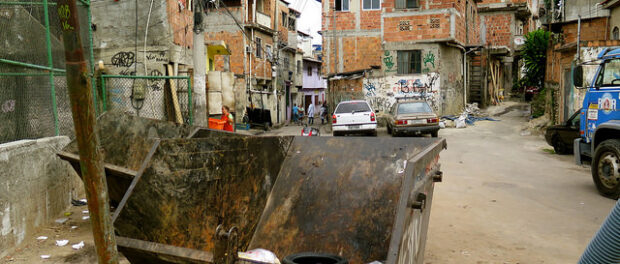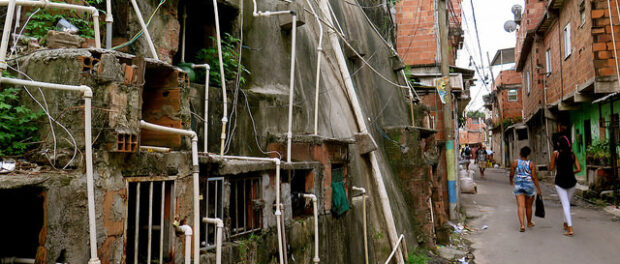
This is the third in a five-part series titled Housing Policy Lessons from Rio’s Favelas. We hope this series will inform debates on housing and favela upgrading and that Rio’s new mayor, Marcelo Crivella, will design policies that address the challenges favelas face while recognizing and strengthening their attributes, by actively engaging with residents in policy design and implementation.
Lesson 5: The day-to-day relationship with the City is marked by distrust due to deceptive ‘participation,’ weak promises, a lack of follow through, and historic precedent
“The City doesn’t come here much. We don’t see anything here of the benefits from the City, even including the preschool that we have.” – Cabritos, South Zone
Favelas are characterized by their informality due to lack of regulation, so by definition the city government has traditionally neglected them. This legacy dates back to the late 19th century when the first favelas appeared on the urban landscape. Since then, the dominant policy towards favelas has been one of denial or neglect.
“Before, public policies never came to the favela. The biggest difficulties don’t come from inside, they come from outside. When you start making a change, it always comes from inside first. Then the public policies come and limit the autonomy, respect and identity of the place. It is never a structural change that comes.” – City of God, West Zone
“We have to pressure the state and look out for our communities because no one looks out for us. We don’t have any representation at all.” – Vidigal, South Zone
The city of Rio should adopt policies that do a better job of understanding how communities work and design programs that offer technical aid and know-how rather than imposing a top-down approach, and that are sustained as necessary.
Based on continuous repetitive experience, administration after administration, residents are suspicious on many fronts: whether a policy’s stated intention to benefit residents is truthfully its aim; whether the community’s priorities established in public meetings will be respected in project design; in what ways the policy’s implementation will differ from how it’s presented or written on paper; whether the policy will come to fruition at all; what sorts of consequences have not been thought through that might appear with implementation; and whether the program will be abandoned mid-implementation.
“I think the housing laws are really good. The laws are marvelous. The problem is the application. I wouldn’t change anything about the laws. I would only better execute these great laws related to housing.” – Babilônia, South Zone
Housing and favela upgrading policies must be executed in a way that will generate trust among residents. Principally, this means legitimate execution and implementation of these projects. Based on historical precedent, residents expect policies to be executed haphazardly and not fully.
Lesson 6: Rio’s communities are changing quickly and proactive policies have never been more important
There is little doubt that Rio has been experiencing massive urban transformations over the past few years that have accompanied the preparations for the World Cup and the Olympics, including public policy programs like Morar Carioca, Minha Casa Minha Vida and the Pacifying Police Units (UPPs).
The massive rise in cost of living in Rio from 2009 through 2014 affected almost all neighborhoods, even favelas like Maré where conflicts with police abound in Rio’s North Zone. In some cases gentrification was at play, even in Rio’s favelas.
“I think this idea of gentrification still doesn’t apply for a variety of reasons [in most neighborhoods]. Where I see indices of gentrification is Vidigal.” – Rio de Janeiro Federal University’s Institute of Urban and Regional Planning Research (UFRJ/IPPUR)
Expensive cities around the world today are working to guarantee affordability through regulation, from New York to London. In Rio, still 20th on the global scale despite Brazil’s recession, nothing is yet being done to reduce this effect and prevent residents from being priced out of their homes.
One approach is for public policies to focus on making the conditions of residents themselves better–investing in the people, not just the place, through empowering programs in education, health, sanitation and general quality-of-life improvements (that do not translate into cost of living increases). This serves the dual benefit of upgrading the area as well as improving the lives of residents and empowering them to stay where they are.
“We know the value of our land.” – Asa Branca, West Zone
While politicians and citizens often see increases in housing costs as “natural” about which “nothing can be done“, academics surveyed for this series saw the increase in prices as a negative phenomenon in need of a policy response.
The truth is that housing costs are influenced by policy and as such policies can be better designed to maintain housing affordable. Explicit policies to do this, none of which have been tried in Rio but all of which have become common in others among the world’s most expensive cities, include rent control and inclusionary zoning, as well as Community Land Trusts.
Instead in Rio there is a claim that the government cannot regulate the value of housing, yet it inadvertently does, and as such stimulates gentrification, by implementing policies like: the provision of poor quality public housing that does not effectively satisfy the demand for housing and thus maintains centrally located favelas as more in-demand and thus expensive; or Pacifying Police Units which, when launched, and without careful regulation, cause major price hikes in centrally located favelas.
Public policy solutions to housing and favela upgrades must be sensitive and aware of these potential effects. As with all cities, in Rio 20-30% of residents cannot afford market rates and policies must be thought up to protect them. Given so many favelas now provide consolidated and functional housing, specific protections are needed to ensure that their residents are able to afford to stay in their communities.
Lesson 7: Titling in favelas is controversial
As a development tool, giving formal individual land titles has long been thought to be the way to go. The argument goes that formal land titling helps residents access credit, provides proof of residency for employment, and ensures legal protections to fight removals or resolve disputes.
“I think it gives greater security of property. You live at a fixed address and so the title is important in giving a little more security to your residence.” – Vidigal, South Zone
Formal programs that included titling have been tried since the Operação Mutirão in the 1960s, the “Each Family One Lot” program in the 1980s, bolstered by the Constitution’s adverse possession provision in 1988, then during the Favela Bairro program during the 1990s and Morar Carioca, which is technically still the City’s upgrading policy today, despite having been abandoned in recent years. However, for those within the favelas, the effects of these titling programs are often unnoticeable.
“This house is mine, but I still never got the deed for it. Also if I don’t have the deed I also cannot sell it. If you have your title, you are naturally protected through your housing. It is important that you have it. If you are not the owner of the land, you can’t fight for it.” – City of God, West Zone
In theory, giving a formal title in a favela can be an important tool to reduce the stigma that is associated with living in an informal settlement. Oftentimes the government will use this stigma around informality to justify policy actions that are paternalistic at best or totalitarian at worst, and limit the rights of favela residents.
“[Titles] can be really good in the sense of taking away the stigma of illegality from the poor population. This stigma was already used for all types of rights violations. In many moments the state relates to the poor populations in this sense – ‘Look, you all are in an illegal situation. You should have been restrained. You should pay for this illegal occupation of the land. So, whatever thing that is done in favor or benefit of you all will be a favor that the state is doing.’ So the state and this stigma of illegality are already putting the poor population in a situation of inferiority.” – UFRJ/IPPUR
That said, holding title in Rio does not necessarily guarantee rights, as was clearly shown with the case of Vila Autódromo, the favela where residents held two titles from the state whose land they inhabited, yet were treated with contempt by the City as the community was slowly and violently dismantled for the Olympic Games.
Also, having a title brings a residence into the formal market, which then automatically puts the resident at risk of instant cost of living increases associated with the formal land tax, utilities, and the ripple effect of an entire neighborhood’s prices going up. A study in the Santa Marta favela found that “the increase in costs associated with regularization of services like electricity, water and cable TV overload the family budget. In addition, some residents of Santa Marta point to increases in price at local bars and small businesses, bakeries and restaurants whose prices have inflated by the new costs which they must pay and by the new clientele with greater means frequenting the community.” For residents who do not have the means to keep up with the increased cost of living that results, they run the risk of being removed by a mechanism that was supposed to have helped them.
Collective titling is one policy idea that could help secure the benefits of titling without its negative consequences. In this scenario residents collectively own the land and individually own their structures, allowing residents to get a return on their investments while being protected from unsympathetic market forces that would push them out. Hence, they get guaranteed permanence for as long as they want it which is the real goal of most favela residents, while still being able to invest in and improve their homes, and also sell them.
“I think titling comes from an old form of education and from old leaders, but I see it very badly today. The land regularization along with the UPP, for me, will accelerate the process of ‘white removal’ in the favelas. You are going to raise the value of your real estate and the favela will turn into a market.” – Babilônia, South Zone
Brazil already has a history of collective titling with its system for quilombos, and some favela leaders think of their communities as essentially urban quilombos, but urban communal titling is still basically untested. Given the collective nature of favelas, this could be an interesting option to test to preserve the character of these communities while stimulating development. In fact, the Lincoln Institute of Land Policy in Boston has repeatedly reported that a system of collective titling that has picked up steam in the United States and Europe–Community Land Trusts–is the most effective at preserving affordable housing both in times of recession (when foreclosure is a real possibility) and boom (when gentrification rears its head).
“If it was well organized, I think it would help because we would have a way of financing. For example, you want to sell your house to leave and the Caixa Econômica will only finance if you have a title of possession or if you have the deed to your house.”– Complexo do Alemão, North Zone
It is important to design collective titling schemes that are participatory and bottom-up. To do this would require making residents aware of the benefits of collective titling and working with them to form participatory networks to support it. Since most favelas in Rio are already on public land, were the government to embrace this approach, it could be more easily workable than even in US cities that have been hoping to expand CLTs. Communities with strong neighborhood associations would be an ideal starting point to see whether this system could produce a viable and replicable, resilient solution.
Full Series: Housing Policy Lessons from Rio’s Favelas
Part 1: Construction and Community
Part 2: Collective Action and Diverse Needs
Part 3: Distrust, Gentrification and Titling
Part 4: Public Housing
Part 5: Proposing Solutions



